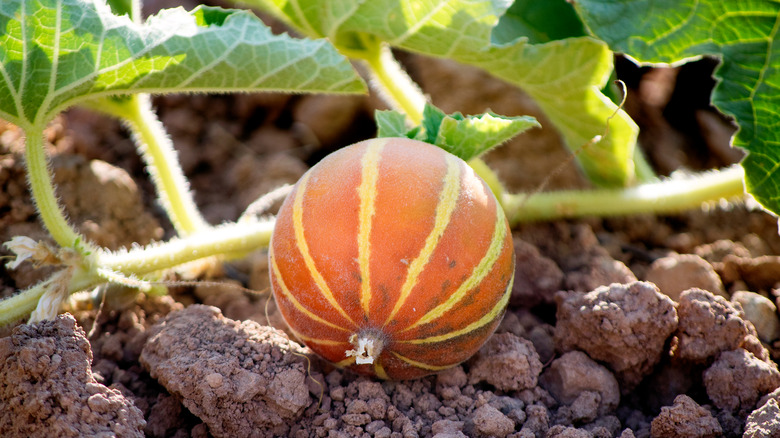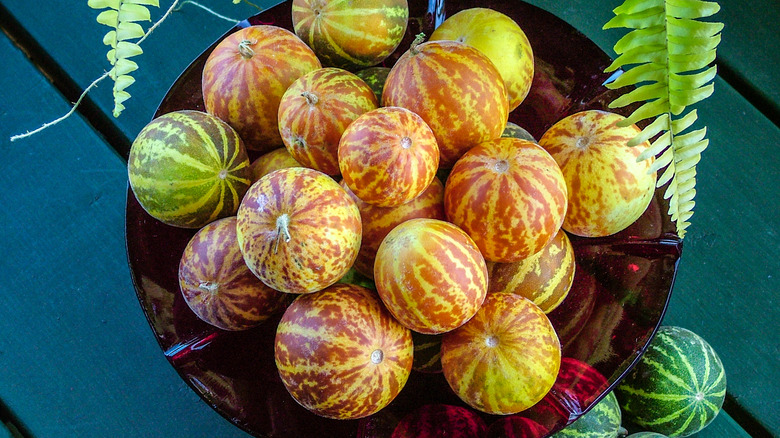Queen Anne's Pocket Melon, The Aromatic Fruit That Doubled As Perfume
Queen Anne's pocket melon, a fleshy fruit that has been grown throughout the Middle East and Northern Africa for millennia, is scientifically classified as Cucumis melo dudaim. When the fruit eventually spread to the New World, new designations were spun; in the 19th-century American South, they were known as "vegetable pomegranates," which later gave way to "plum grannies." But how did they come to be called Queen Anne's pocket melon?
The fruit's most common name references its most distinctive quality, the incredible smell. While it's not clear which fragrant Queen Anne gave her name to the melon (likely Queen Anne of England), people have been carrying the melons around for their scent since antiquity. In 9th century Iran, the fruits were called "dastanbouya," a word that translates to "hand perfume." They've been used to scent homes for generations, and nefarious fruitmongers even hid them in crates to mask the scent of their spoiling wares.
Over the centuries, Queen Anne's pocket melons have fallen in and out of favor. After waning popularity throughout the 19th century, they came surging back after catching the attention of Victorian farmers and gardeners. While they've mostly fallen into obscurity, they can be spotted from time to time and could become in vogue again. As one writer told The Journal of Horticulture in 1867, "This miniature melon is, I believe, of very ancient date, and is like an 'old coat' or 'old song,' destined to become quite in the fashion again."
What is Queen Anne's pocket melon?
Roughly the size of a tennis ball, Queen Anne's pocket melons are small and round with a smooth, slightly velvety texture. Their skin is mottled with stripes. When young, the stripes are green; an immature pocket melon could be mistaken for a watermelon, but the stripes turn orange with age. If you cut one open, you'll find thick flesh with a gelatinous mass of seeds toward the center. The fruit spread from the Middle East to Portugal, to England in the 18th century, and from there to America. There, the melon became a beloved garden staple throughout Appalachia and the Ozarks.
While Queen Anne's pocket melons are edible, they're typically grown for their remarkable aroma. In addition to a strong melon scent, like an intensified honeydew or cantaloupe, writers describe notes of jasmine or pineapple. To some, the scent is overwhelming. It can be reminiscent of indole, an organic compound often used in perfume.
What does Queen Anne's pocket melon taste like?
While Queen Anne's pocket melon is best known for its scent, the fruit is edible too. However, by all accounts, the taste pales in comparison to its disarming scent. While Farmacie Isolde derides them for being "watery and insipid," few would disagree that the fruit is largely flavorless. It's often likened to a mild cucumber with a soft, spongy texture.
Some historical sources claimed that Queen Anne's pocket melon was inedible, but there's plenty of evidence that resourceful cooks used it for jams, jellies, and pickles. Historically, they were often used for "mangoes," an old-fashioned misnomer for fruits and vegetables that were stuffed with spices and pickled. Occasionally, the smelly little melons were eaten raw — though one 19th-century source recommended serving them with sugar and wine to give them a sweeter, more palatable flavor. Modern recipes suggest scooping out the insides and filling the serving-sized melons with granita.
Where can you buy Queen Anne's pocket melon?
While Queen Anne's pocket melons are a major crop in some parts of the world, they are hard, if not impossible, to buy in the U.S. as fruits. Thanks to their uninspiring taste and "weedy" growing habits, the fruits are typically eschewed by commercial growers. If you want to give them a try, your best bet may be to grow them yourself. The little melons are popular among heirloom gardeners, and seeds are available online, but be forewarned: Queen Anne's pocket melons are considered invasive in Florida, Arizona, and California.
However, cultivators haven't entirely dismissed the possibility of commercial applications. A 2020 paper published in "Horticultural Science" explored the possibility of cross-breeding Queen Anne's pocket melons with Piel de Sapo melons. One of the most popular varieties in Spain, Piel de Sapo melons are sweet, flavorful, and nutritious but also large and heavy. Researchers found that breeding the two varieties produced smaller, rounder, "personal-sized" melons with a delicate flavor, ideal for individual consumption. With such a long history, the Queen Anne's pocket melon is sure to come back — though perhaps in a new and different form.



